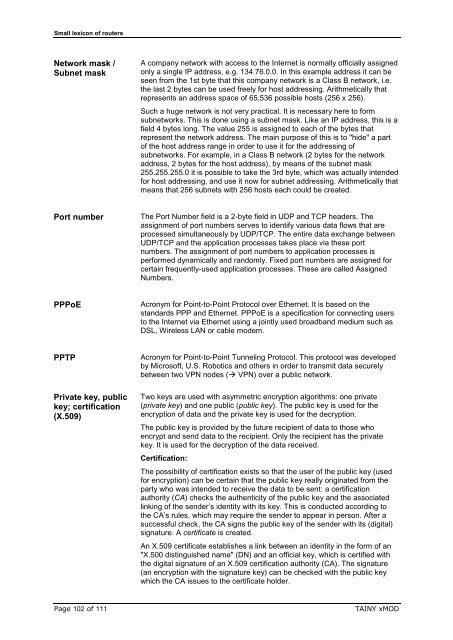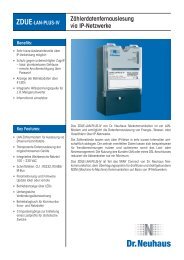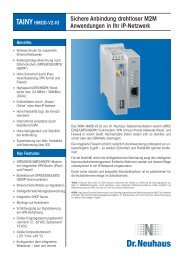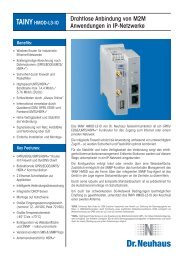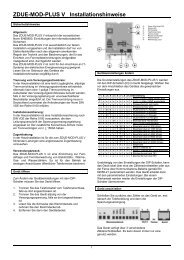tainy hmod-v3-io, tainy hmod-l3-io - Dr. Neuhaus ...
tainy hmod-v3-io, tainy hmod-l3-io - Dr. Neuhaus ...
tainy hmod-v3-io, tainy hmod-l3-io - Dr. Neuhaus ...
You also want an ePaper? Increase the reach of your titles
YUMPU automatically turns print PDFs into web optimized ePapers that Google loves.
Small lexicon of routers<br />
Network mask /<br />
Subnet mask<br />
A company network with access to the Internet is normally officially assigned<br />
only a single IP address, e.g. 134.76.0.0. In this example address it can be<br />
seen from the 1st byte that this company network is a Class B network, i.e.<br />
the last 2 bytes can be used freely for host addressing. Arithmetically that<br />
represents an address space of 65,536 possible hosts (256 x 256).<br />
Such a huge network is not very practical. It is necessary here to form<br />
subnetworks. This is done using a subnet mask. Like an IP address, this is a<br />
field 4 bytes long. The value 255 is assigned to each of the bytes that<br />
represent the network address. The main purpose of this is to "hide" a part<br />
of the host address range in order to use it for the addressing of<br />
subnetworks. For example, in a Class B network (2 bytes for the network<br />
address, 2 bytes for the host address), by means of the subnet mask<br />
255.255.255.0 it is possible to take the 3rd byte, which was actually intended<br />
for host addressing, and use it now for subnet addressing. Arithmetically that<br />
means that 256 subnets with 256 hosts each could be created.<br />
Port number The Port Number field is a 2-byte field in UDP and TCP headers. The<br />
assignment of port numbers serves to identify var<strong>io</strong>us data flows that are<br />
processed simultaneously by UDP/TCP. The entire data exchange between<br />
UDP/TCP and the applicat<strong>io</strong>n processes takes place via these port<br />
numbers. The assignment of port numbers to applicat<strong>io</strong>n processes is<br />
performed dynamically and randomly. Fixed port numbers are assigned for<br />
certain frequently-used applicat<strong>io</strong>n processes. These are called Assigned<br />
Numbers.<br />
PPPoE Acronym for Point-to-Point Protocol over Ethernet. It is based on the<br />
standards PPP and Ethernet. PPPoE is a specificat<strong>io</strong>n for connecting users<br />
to the Internet via Ethernet using a jointly used broadband medium such as<br />
DSL, Wireless LAN or cable modem.<br />
PPTP Acronym for Point-to-Point Tunneling Protocol. This protocol was developed<br />
by Microsoft, U.S. Robotics and others in order to transmit data securely<br />
between two VPN nodes (� VPN) over a public network.<br />
Private key, public<br />
key; certificat<strong>io</strong>n<br />
(X.509)<br />
Two keys are used with asymmetric encrypt<strong>io</strong>n algorithms: one private<br />
(private key) and one public (public key). The public key is used for the<br />
encrypt<strong>io</strong>n of data and the private key is used for the decrypt<strong>io</strong>n.<br />
The public key is provided by the future recipient of data to those who<br />
encrypt and send data to the recipient. Only the recipient has the private<br />
key. It is used for the decrypt<strong>io</strong>n of the data received.<br />
Certificat<strong>io</strong>n:<br />
The possibility of certificat<strong>io</strong>n exists so that the user of the public key (used<br />
for encrypt<strong>io</strong>n) can be certain that the public key really originated from the<br />
party who was intended to receive the data to be sent: a certificat<strong>io</strong>n<br />
authority (CA) checks the authenticity of the public key and the associated<br />
linking of the sender’s identity with its key. This is conducted according to<br />
the CA’s rules, which may require the sender to appear in person. After a<br />
successful check, the CA signs the public key of the sender with its (digital)<br />
signature. A certificate is created.<br />
An X.509 certificate establishes a link between an identity in the form of an<br />
"X.500 distinguished name" (DN) and an official key, which is certified with<br />
the digital signature of an X.509 certificat<strong>io</strong>n authority (CA). The signature<br />
(an encrypt<strong>io</strong>n with the signature key) can be checked with the public key<br />
which the CA issues to the certificate holder.<br />
Page 102 of 111 TAINY xMOD


